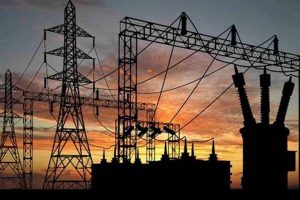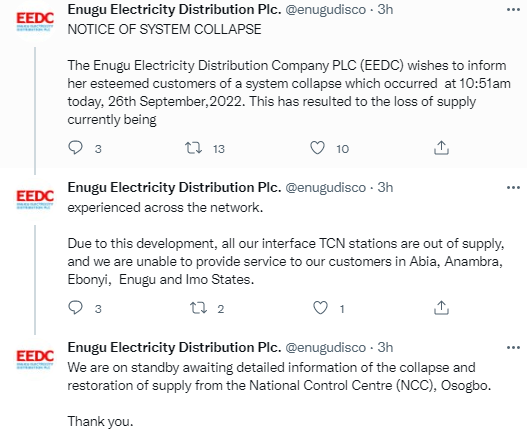
Consumers in the country may have to endure a while, as the electricity transmission grid has collapsed again, throwing the nation into darkness.
The Enugu Electricity Distribution Company PLC (EEDC), which confirmed this in a statement to its customers, said that works are ongoing by engineers of Transmission Company of Nigeria (TCN) to fix the system.
Head, Corporate Communications, EEDC, Emeka Ezeh, in the “EEDC wishes to inform her esteemed customers of a system collapse which occurred at 10:51am today, 26th September,2022. This has resulted to the loss of supply currently being experienced across the network.
Due to this development, all our interface TCN stations are out of supply, and we are unable to provide service to our customers in Abia, Anambra, Ebonyi, Enugu and Imo States.
We are on standby awaiting detailed information of the collapse and restoration of supply from the National Control Centre (NCC), Osogbo.
An industry expert and former General Manager, Corporate Communications, Niger Delta Power Holding Company (NDPHC), Yakubu Lawal, had recently said that the power outages associated with system collapse from the national grid will not end soon, going by the capacity and poor integrity of the system.
Lawal enjoined the government and the stakeholders to endeavour to inject more transmission facilities and distribution transformers for the nation to enjoy a reliable power supply.
He said: “We have a fragile network to the extent that any little obstruction to the system, will trigger off the network and the system collapses. The capacity of transmission companies to wheel power is not so much. They are talking about 4,000 Mega Watts (MW) or 5,000MW, but in actual sense, they cannot wheel 4,000MW consistently for three hours.
“We now find a situation whereby the generation companies generate power, but for the national grid to evacuate the power becomes a problem. That is why when you visit any of the control rooms in any of the generation companies, the control centre keep asking them to shut down one unit or the other, just to make sure they are able to balance the load so that it will not affect the network.
“Ordinarily, the scenario is that if you have, for instance, 7,000MW generation capacity, you should be able to boast of something above 8,000MW transmission capacity.
“And when you come to distribution, you should be able to have a capacity higher than the generation and transmission.
“If you have that kind of scenario, the transmission will be able to handle it conveniently and the distribution will also be able to absorb them conveniently for the general public to enjoy,” he explained6018225788.
Lawal said it may be painful to know that Nigeria has not come to the end of power system collapse. “It is not something you can overcome overnight. You will have to inject more facilities, you will have to inject power transformers, you have to improve the connectivity of your transmission lines and ensure you have a stable and consistent capacity level. But as it is today, I can tell you that we have not seen the end of the system collapse.










